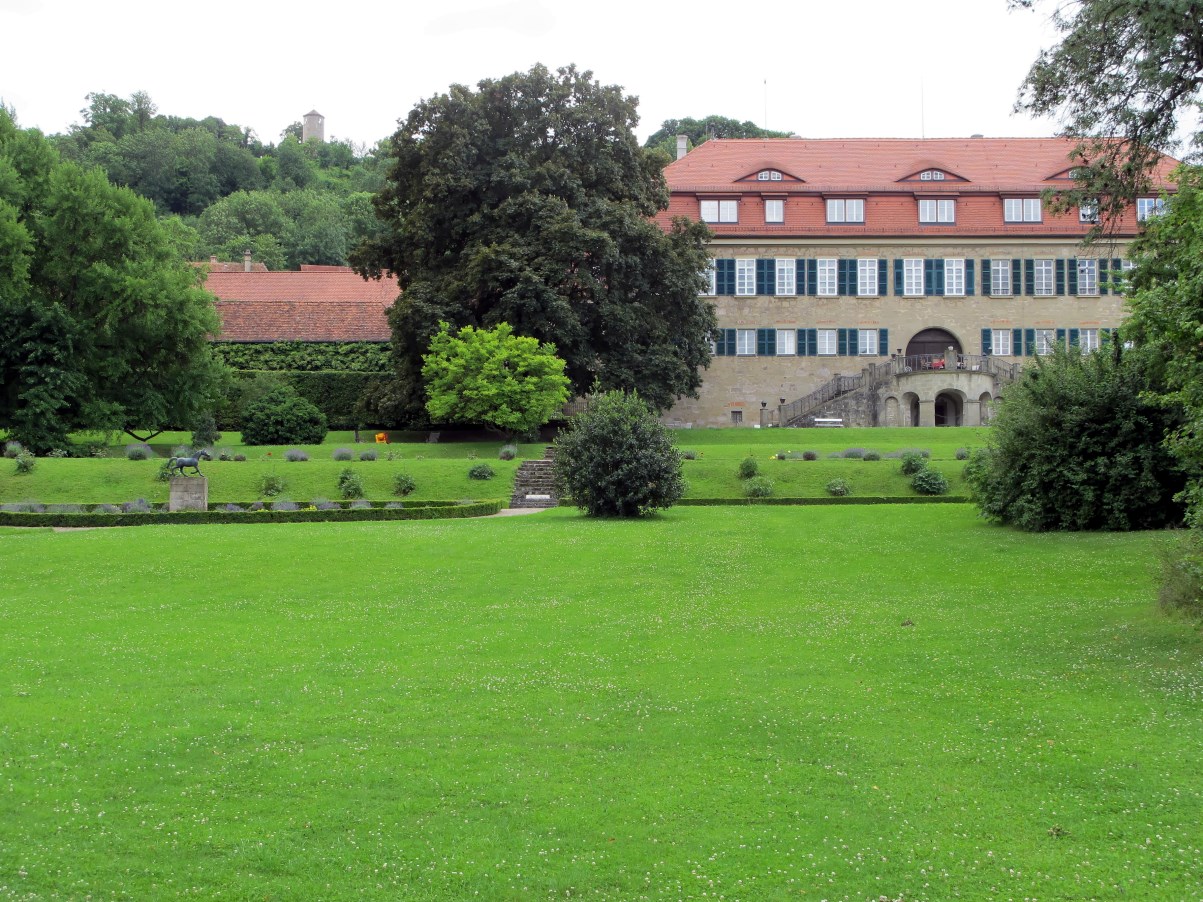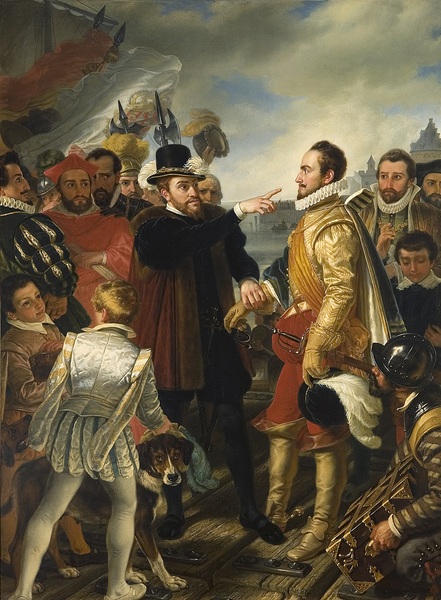|
Castle Beverweerd
Beverweerd Castle is a 13th century castle and former knight's court town, which is located on an island along the Kromme Rijn near the village of Werkhoven in the Dutch province of Utrecht. The castle is surrounded by landscaped gardens, in which the Kromme Rijn itself plays an important role in the landscape. The castle was empty for a long time and was not open to the public. Since 2006, painter and art forger Geert Jan Jansen has lived and worked at Beverweerd Castle. The surrounding gardens are ideal for walking, which offers a good view of the castle and the Kromme Rijn. History The oldest known inhabitant of Beverweerd is knight Zweder van Zuylen. On 27 October 1536 'Klein Zuilenburg' was recognized as knightly good by the States of Utrecht. In 1563, Philip William, Prince of Orange, the eldest son of William the Silent, inherited Beverweert; after his death, the castle came into the hands of his half-brother Maurice in 1620, after which it remained in the hands of the Hous ... [...More Info...] [...Related Items...] OR: [Wikipedia] [Google] [Baidu] |
Utrecht
Utrecht ( , , ) is the fourth-largest city and a municipality of the Netherlands, capital and most populous city of the province of Utrecht. It is located in the eastern corner of the Randstad conurbation, in the very centre of mainland Netherlands, about 35 km south east of the capital Amsterdam and 45 km north east of Rotterdam. It has a population of 361,966 as of 1 December 2021. Utrecht's ancient city centre features many buildings and structures, several dating as far back as the High Middle Ages. It has been the religious centre of the Netherlands since the 8th century. It was the most important city in the Netherlands until the Dutch Golden Age, when it was surpassed by Amsterdam as the country's cultural centre and most populous city. Utrecht is home to Utrecht University, the largest university in the Netherlands, as well as several other institutions of higher education. Due to its central position within the country, it is an important hub for both rail and road t ... [...More Info...] [...Related Items...] OR: [Wikipedia] [Google] [Baidu] |
House Of Nassau
The House of Nassau is a diversified aristocratic dynasty in Europe. It is named after the lordship associated with Nassau Castle, located in present-day Nassau, Rhineland-Palatinate, Nassau, Rhineland-Palatinate, Germany. The lords of Nassau were originally titled "Count of Nassau", then elevated to the princely class as "Princely Counts". Early on they divided into two main branches: the elder (Walramian) branch, that gave rise to the German king Adolf, King of the Romans, Adolf, and the younger (Ottonian) branch, that gave rise to the Prince of Orange, Princes of Orange and the King of the Netherlands, monarchs of the Netherlands. At the end of the Holy Roman Empire and the Napoleonic Wars, the Walramian branch had inherited or acquired all the Nassau ancestral lands and proclaimed themselves, with the permission of the Congress of Vienna, the "Dukes of Nassau", forming the independent state of Duchy of Nassau, Nassau with its capital at Wiesbaden; this territory today main ... [...More Info...] [...Related Items...] OR: [Wikipedia] [Google] [Baidu] |
Kasteel Beverweerd In Werkhoven (1901–2003), a Dutch journalist, diplomat, and colonial administrator
{{disambig ...
Kasteel is the Dutch language word for a castle or château. It can also refer to: * Sparta Stadion Het Kasteel, a football stadium * Joop Kasteel (born 1964), a Dutch mixed martial artist * Piet Kasteel Petrus Albertus "Piet" Kasteel (4 November 1901 – 13 December 2003) was a Dutch journalist, diplomat, and colonial administrator. He was parliamentary editor of ', and fled to England during World War II where he served for the Dutch government- ... [...More Info...] [...Related Items...] OR: [Wikipedia] [Google] [Baidu] |
Castell-Castell
Castell-Castell was a county in the Holy Roman Empire, ruled by a branch of the Counts of Castell. It was established as a partition of Castell-Remlingen in 1668, and it was partitioned between itself and Castell in 1709. It annexed the County of Castell in 1772, and was mediatised to Bavaria in 1806.Genealogisches Handbuch des Adels, Fürstliche Häuser XVI. "Castell". C.A. Starke Verlag, 2001, pp. 187-190. (German). . Counts of Castell-Castell (1668–1806) *Wolfgang Theodoric (1668–1709) *Augustus Francis Frederick (1709–1767) reigned mutually with *Charles Frederick Gottlieb (Count of Castell-Remlingen) (1709–1717) and *Wolfgang George II (1709–1736) and *Christian Frederick Charles (Count of Castell-Rüdenhausen (1736–1773) *Albert Frederick Charles (1773–1806) mutually with *Christian Frederick (later Count of Castell-Rüdenhausen) (1773–1803) (Mediatized) Counts of Castell-Castell * Friedrich Ludwig (1810-1875) * Carl (1875-1886) * Friedrich Carl (1886- ... [...More Info...] [...Related Items...] OR: [Wikipedia] [Google] [Baidu] |
Van Rechteren
The House of Rechteren (also van Rechteren-Limpurg) is the name of an old noble family belonging to the Dutch and German nobility. The German branch of Countsvon Rechteren-Limpurg-Speckfeld has been mediatised. History The family was already noble from earliest times ("Uradel"). The first documented ancestor is Fredericus van Hekeren van der Ese (mentioned 1295) who was an adviser to Reginald II of Guelders. His grandson Frederik van Heeckeren van der Eze (1320-ca. 1386) was the head of the ''Heeckerens'' faction during the War of the Guelderian Succession. Through his marriage with 'Lutgardis van Voorst, whose ancestors owned both the castle Rechteren near Dalfsen as well as the castle Voorst near Zwolle, the surname ''van Rechteren'' entered the family. In 1432, Frederik's grandson, Frederik van Hekeren genaamd van Rechteren († 1462) married Cunegonde van Polanen. Their son Otto van Hekeren genaamd van Rechteren († 1478) inherited Castle Rechteren and became the ances ... [...More Info...] [...Related Items...] OR: [Wikipedia] [Google] [Baidu] |
Maurice, Prince Of Orange
Maurice of Orange ( nl, Maurits van Oranje; 14 November 1567 – 23 April 1625) was ''stadtholder'' of all the provinces of the Dutch Republic except for Friesland from 1585 at the earliest until his death in 1625. Before he became Prince of Orange upon the death of his eldest half-brother Philip William in 1618, he was known as Maurice of Nassau. Maurice spent his youth in Dillenburg in Nassau, and studied in Heidelberg and Leiden. He succeeded his father William the Silent as stadtholder of Holland and Zeeland in 1585, and became stadtholder of Utrecht, Guelders and Overijssel in 1590, and of Groningen in 1620. As Captain-General and Admiral of the Union, Maurice organized the Dutch rebellion against Spain into a coherent, successful revolt and won fame as a military strategist. Under his leadership and in cooperation with the Land's Advocate of Holland Johan van Oldenbarnevelt, the Dutch States Army achieved many victories and drove the Spaniards out of the north ... [...More Info...] [...Related Items...] OR: [Wikipedia] [Google] [Baidu] |
Netherlands
) , anthem = ( en, "William of Nassau") , image_map = , map_caption = , subdivision_type = Sovereign state , subdivision_name = Kingdom of the Netherlands , established_title = Before independence , established_date = Spanish Netherlands , established_title2 = Act of Abjuration , established_date2 = 26 July 1581 , established_title3 = Peace of Münster , established_date3 = 30 January 1648 , established_title4 = Kingdom established , established_date4 = 16 March 1815 , established_title5 = Liberation Day (Netherlands), Liberation Day , established_date5 = 5 May 1945 , established_title6 = Charter for the Kingdom of the Netherlands, Kingdom Charter , established_date6 = 15 December 1954 , established_title7 = Dissolution of the Netherlands Antilles, Caribbean reorganisation , established_date7 = 10 October 2010 , official_languages = Dutch language, Dutch , languages_type = Regional languages , languages_sub = yes , languages = , languages2_type = Reco ... [...More Info...] [...Related Items...] OR: [Wikipedia] [Google] [Baidu] |
William The Silent
William the Silent (24 April 153310 July 1584), also known as William the Taciturn (translated from nl, Willem de Zwijger), or, more commonly in the Netherlands, William of Orange ( nl, Willem van Oranje), was the main leader of the Dutch Revolt against the Spanish Habsburgs that set off the Eighty Years' War (1568–1648) and resulted in the formal independence of the United Provinces in 1648. Born into the House of Nassau, he became Prince of Orange in 1544 and is thereby the founder of the Orange-Nassau branch and the ancestor of the monarchy of the Netherlands. In the Netherlands, he is also known as Father of the Fatherland ('' Pater Patriae'') ( nl, Vader des Vaderlands). A wealthy nobleman, William originally served the Habsburgs as a member of the court of Margaret of Parma, governor of the Spanish Netherlands. Unhappy with the centralisation of political power away from the local estates and with the Spanish persecution of Dutch Protestants, William joined the ... [...More Info...] [...Related Items...] OR: [Wikipedia] [Google] [Baidu] |
Philip William, Prince Of Orange
Philip William, Prince of Orange (19 December 1554 in Buren, Gelderland – 20 February 1618) was the eldest son of William the Silent by his first wife Anna van Egmont. He became Prince of Orange in 1584 and Knight of the Golden Fleece in 1599. Biography Philip William, Filips Willem in Dutch, was born on 19 December 1554 in Buren, Guelders, Seventeen Provinces. He was the first son of William the Silent and Anna van Egmont. When his father William the Silent ignored Alva's summons to return to Brussels, remaining in Germany, Philip William, only a boy of 13, was studying at the University at Leuven in Duchy of Brabant, Brabant. He was seized in February 1568, and taken to Spain partly as a hostage, but especially to be raised as a good Catholic and loyal subject. He would never see his father again (his mother had already died ten years earlier). In Spain he continued his studies at the university of Alcalá de Henares. He remained in Spain until 1596 when he returned ... [...More Info...] [...Related Items...] OR: [Wikipedia] [Google] [Baidu] |

.jpg)

